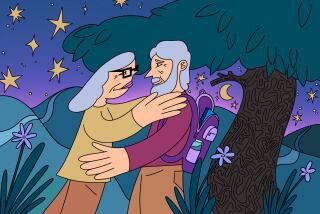Love and Happiness
The marriage vow stipulates “Till death us do part,” but at the end of the century, maybe it should be amended to: Till death, duplicity, desertion or divorce replaces that first fine careless rapture.
There’s love and passion, indeed--and their postscripts--in this encyclopedic look at nearly 100 famous couples from 26 countries. They range from Albert and Elisabeth of Belgium in 1900 to Linda and Paul McCartney in 1998. In between there are artists, writers, actors, scientists, athletes, revolutionaries--heterosexuals, bisexuals and homosexuals. For each year, there’s a brief sidebar about other couples or events that made sociological news.
First published in France, the book, adorned with a huge red heart on the pink cover, includes an intense, but very readable, analysis of how Eros has been transformed during the whirlwind 20th century. Introducing each year are sections on a social phenomenon connected with love under 11 classifications: society, the law, morals, sexology, writings, sensuality, myths, anguish, feelings, images and pleasure.
Florence Montreynaud, a Parisian mother of four, has written eight books, including “The Hidden Side of Prostitution” and “The Twentieth Century of Women.” Clearly a feminist without rancor, she views her subject with as candid and nonjudgmental an eye as Dr. Ruth’s.
There’s also much to delight the eye in this handsome publication, from magnificent photographs of couples to devilishly clever cartoons, posters and full-color reproductions of famous paintings, including a Chagall illustration for the Song of Songs, Egon Schiele’s “Self Portrait of the Artist Masturbating,” Miguel Covarrubias’ stern Dr. Freud at the bedside of curvaceous Jean Harlow and Frida Kahlo’s “Diego and Me” with its miniature portrait of Rivera between her eyebrows.
Piquant tidbits enliven the text:
* The Italian Highway Code prohibits French kissing while driving.
* The traditional wedding ring location stems from the ancient Greek belief that it was the heart finger because it contained the love vein.
* In Buenos Aires in 1906, police reinstated an 1889 decree that punished a man who complimented a woman on the street with fine of 50 pesos.
* In Eastern art, the image of the vulva is represented as a lotus flower, a peach or an apricot, while French women writers have referred to the penis as “the root of the world” (Violette Leduc), “the living cigar” (Joyce Mansour) and the “fabulous serpent” (Emmanuelle Arsan).
Montreynaud does not gloss over the extracurricular affairs of presidents, from Franklin Delano Roosevelt to John F. Kennedy, Bill Clinton and Francois Mitterand.
In two articles under the classification “sensuality,” Montreynaud uses films to illustrate her discussions of taboo subjects. Marco Bellocchio’s 1986 “Devil in the Flesh” had a scandalous scene of fellatio. The media did not exactly take that in stride. The actress Maruschka Detmers was forced to explain that 17-second act in 857 interviews. And referring to Bernardo Bertolucci’s controversial “Last Tango in Paris,” Montreynaud asks: “Perversion or a diversion? Is sodomy a harmless practice?” Marlon Brando’s tactical use of butter in that film is no joke, she says. Citing passages in the Bible, the Kama Sutra, the Marquis de Sade’s “Philosophy in the Bedroom,” “Lady Chatterley’s Lover” and “The Story of O,” she notes that the Kinsey reports “are very quiet on the subject” of sodomy but that the Spira report into French sexual behavior reveals that 30% of men and 24% of women have practiced it. If it is practiced for one reason or another, Montreynaud advises men to exhibit “delicacy and patience.”
In her introductory historical survey, Montreynaud points out that love “has been raised to the status of a universal myth. . . . Collectively, it is turning into an ideology with overtones of religion: At a time when Christianity is in free-fall and traditional religious values are losing their appeal, the fervour once invested in faith seems to have been channeled into expectations of love.” In the United States, she notes, “the excessive idealization of love led to a reliance upon the life of the couple that was ultimately stifling. . . . The conclusion is obvious: lacking the oxygen of contact with the outside world, relations within a couple will wither away.” She believes that the emergence of the “couple of equals” is one of the century’s “major advances in the area of relations between men and women.”
The most fulfilling lifelong relationships seemed to reside in those couples who shared mutual interests and work: Beatrice and Sidney Webb, Alfred Stieglitz and Georgia O’Keeffe, Pierre and Marie Curie, Gunnar and Alva Myrdal, Benjamin Britten and Peter Pears, Melina Mercouri and Julies Dassin, Paul Newman and Joanne Woodward, Gena Rowlands and John Cassavetes, Andrei Sakharov and Elena Boner.
Other lives may have had rockier moments, but the passions that united them forever couple their names: Anton Chekhov and Olga Knipper, Gustav and Alma Mahler, Emma Goldman and Alexander Berkman, Scott and Zelda Fitzgerald, Kurt Weill and Lotte Lenya, Simone de Beauvoir and Jean-Paul Sartre, Ingrid Bergman and Roberto Rossellini, Liv Ullmann and Ingmar Bergman and the Rosenbergs.
Although a great deal is known about many of these couples, Montreynaud offers new insights into their romantic lives. For instance, take the case of the formidable Rebecca West and H.G. Wells, who never married but had a son together. “She dreamed up stories in which he was a jaguar and she a panther and whose adventures he sketched in his letters. One delightful drawing by Wells shows the two big cats, swollen with pride, saying to each other: ‘You should have heard my speech!’ The caption asks: ‘Can love exist between two people of this type?’ ” Years later, Wells’ last companion, Moura Boudberg, was asked if she was attracted by his intelligence or his sense of humor. “Not at all,” she replied. “It was because his body smelled of honey.”
Some of the photographs offer unexpected glimpses into personalities: Jawaharlal Nehru doubled up in an impish laugh between Lord and Lady Mountbatten ( Nehru had an affair with Lady Mountbatten); the Communist Clara Zetkin striding out of the Reichstag with an irrepressible smile; and an eerie photo montage of Sartre and de Beauvoir.
Conceding that “it is difficult to be a man in the present world,” Montreynaud nevertheless predicts that a new style of relationship is now appearing. “In the social mores being established for tomorrow’s world, which are more demanding and based on adult choices, the love relationship becomes one of equality and good relations, founded on mutual trust.” Amen!
More to Read
Sign up for our Book Club newsletter
Get the latest news, events and more from the Los Angeles Times Book Club, and help us get L.A. reading and talking.
You may occasionally receive promotional content from the Los Angeles Times.









